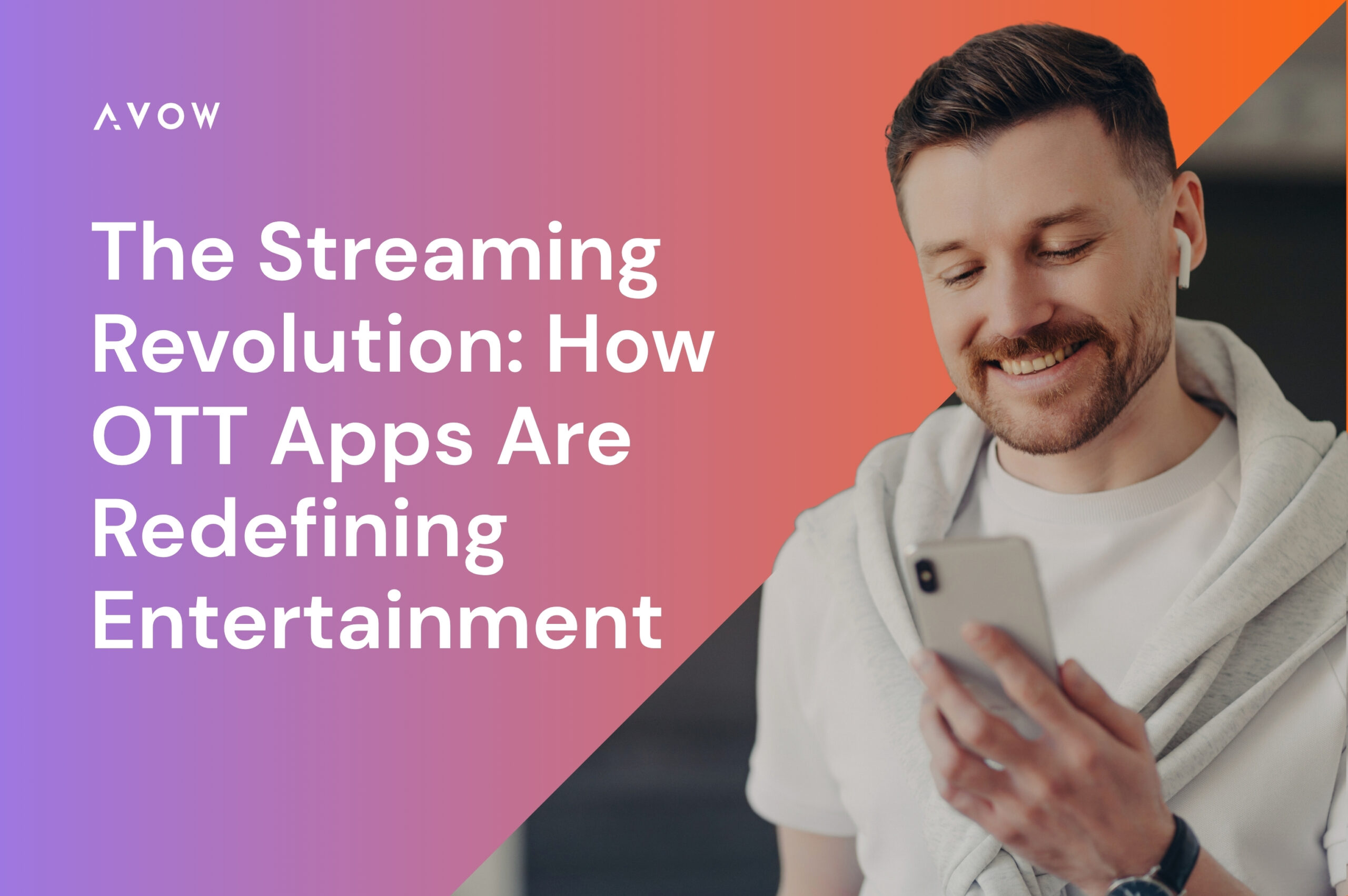The global OTT market is not just growing, it’s skyrocketing. By 2025, it’s projected to reach a staggering revenue of $343 billion, with an annual compound growth rate of 6.56 percent. This seismic growth is reshaping the entertainment industry, swiftly transitioning from scheduled viewing to instant access. The driving force behind this transformation is OTT (Over-the-Top) apps, which directly deliver content over the internet, bypassing traditional distribution channels such as cable and satellite providers. The ascent of these platforms is revolutionizing how we consume media and experience entertainment, disrupting the traditional TV model and making OTT apps a cornerstone of modern digital culture.
For media professionals, understanding the evolution of OTT apps is not only crucial but also a necessity. This knowledge is the key to navigating the dynamic supply chain and securing future opportunities in the rapidly changing entertainment landscape.

The early days: The foundation of on-demand access
Did you know that around 5.27 billion people use OTT apps worldwide today? India has the highest number of OTT users globally, with an estimated 601.2 million. It is due to its large population and the increasing popularity of streaming services like Netflix, Amazon Prime Video, and others.
The streaming revolution didn’t happen overnight; it started in the early 2000s, fueled by the expansion of broadband internet. Initially, streaming platforms faced several challenges, including slow loading speeds, subpar video quality, and limited content options. The primary technological hurdles focused on enhancing bandwidth efficiency and accommodating early streaming protocols.
Important milestones during this foundational period established both the viability and demand for on-demand content:
1995: RealNetworks launched one of the earliest solutions for streaming audio and video, pioneering the technology.
2005: YouTube came into existence, thus transforming user-generated content and the way short-form videos were consumed, proving the widespread public desire for digital video.
2007: Netflix rolled out its streaming service in conjunction with its well-known DVD rental business, strategically laying the groundwork for contemporary SVOD (Subscription Video on Demand).
These platforms played a crucial role in creating high-quality, readily accessible entertainment, which directly contributed to the tremendous rise in popularity of subscription-based services.
SVOD dominance: Redefining consumption and production
The Subscription Video on Demand (SVOD) model rapidly became the dominant force, allowing users to access vast content libraries for a predictable monthly fee. Platforms such as Netflix, Hulu, and later Disney+ and HBO Max capitalized on this shift, offering exclusive original content and securing global licensing deals.
1. The value proposition of OTT apps
Convenience and personalization: The unparalleled accessibility and convenience offered by OTT apps empowered consumers, allowing them to tailor their viewing experience according to their preferences and schedules.
On-demand access: Users could watch movies, TV shows, and even live events at their convenience across multiple devices, freeing them from fixed broadcasting schedules.
Personalized experience: A key advantage of OTT platforms is their ability to leverage sophisticated algorithms and user data to provide tailored recommendations. By analyzing viewing patterns, these platforms generate content suggestions tailored to personal preferences, which significantly boost engagement and satisfaction.
Multi-generational appeal: This model succeeded by adapting tactics to accommodate distinct age groups: catering to Millennials’ reliance on mobile accessibility and original content; appealing to Gen Z’s preference for short-form, interactive, and diverse content; and attracting older generations with nostalgic classics and user-friendly interfaces.

2. The content wars: Funding originals and exclusivity
To drive user acquisition and retention in an increasingly competitive space, platforms are investing heavily in the creation of original content. This pursuit of exclusivity and flagship programming gave rise to a new era of streaming-exclusive content, fundamentally reshaping pop culture. The sheer volume of this content explosion led to what became known as the “streaming wars”. This financial outlay provided viewers with a diverse range of choices beyond traditional television.
3. Disrupting traditional media and cord-cutting
The collective impact of OTT apps has been nothing short of a revolution in the entertainment industry, significantly disrupting traditional media and consumption patterns. This disruption is not just a trend; it’s a seismic shift that is reshaping the entire industry landscape.
Direct-to-Consumer (DTC) strategy: Companies such as Disney and other significant entities have begun to circumvent conventional distributors and intermediaries, allowing creators to maintain greater control over their content and revenue strategies.
Accelerated releases: The windows between theatrical releases and availability on streaming services have been dramatically shortened, a precedent accelerated by the global pandemic.
The cord-cutting phenomenon: The immense popularity and convenience of streaming contributed significantly to the “cord-cutting” phenomenon, where viewers abandoned traditional cable and satellite subscriptions in favor of flexible, on-demand platforms. This disruption was permanent, compelling conventional broadcasters and content creators to adopt digital-first strategies to remain competitive.

Evolution beyond subscription
As the market matured and content costs soared, OTT platforms continued to innovate both their business and distribution strategies.
1. The hybrid and AVOD imperative
Subscription fatigue eventually set in as consumers found themselves paying for multiple services (the average user subscribes to 4.2 services ). It necessitated a strategic pivot to diversify revenue:
Ad-supported models: The rise of Advertising-Based Video on Demand (AVOD) provided a way to reach broader audiences, integrating targeted advertising to offer free or reduced-cost access to content.
Hybrid models: Platforms like Hulu and Peacock have successfully implemented tiered models, offering both ad-supported and ad-free tiers, which maximize revenue streams while retaining budget-conscious viewers.
2. Global expansion and localization
OTT apps, aiming to tap into their complete market potential, are now focusing on global audiences and overcoming geographical limitations. This expansion has been underpinned by extensive localization efforts, ensuring that the content resonates with diverse cultures and languages.
Content adaptation: Companies invested heavily in high-quality dubbing, subtitling, and media adaptation services to overcome licensing, regulatory, and cultural hurdles.
Industry partners: Localization vendors like Zoo Digital, Iyuno, and TransPerfect became key players, ensuring seamless language and cultural adaptation for global releases.
3. Pushing the boundaries of the user experience
Innovation in the user experience became paramount for battling churn. Platforms continually invest in advanced features and technologies:
Interactive features: Features like offline viewing, multi-device synchronization, and integrated social sharing enriched the experience.
Technological optimization: Platforms began focusing on enhancing high-definition (HD) and ultra-high-definition (UHD) content through the implementation of adaptive bitrate technologies, which enable smooth playback despite fluctuating internet speeds.
Immersive features: Developers began incorporating futuristic elements like Virtual Reality (VR) and Augmented Reality (AR) to enhance engagement, offering interactive storytelling and virtual event attendance.
Conclusion: The continued evolution
The journey from early, buffering streaming services to today’s highly personalized, multi-billion-dollar OTT giants reflects a remarkable transformation in the entertainment landscape, driven by consumer needs. Initially hindered by slow internet speeds and limited content, these platforms rapidly innovated as technology advanced and demand for on-demand content grew.
Success in OTT is about more than just content; it’s in the delivery. Through sophisticated algorithms and data analytics, these platforms provide personalized recommendations, enhancing viewer engagement. The competition among OTT services has spurred continuous improvement, resulting in significant investments in original content that caters to diverse interests and demographics.
Moreover, the globalization of these platforms has made international content accessible, allowing audiences to explore narratives from various cultures. As the industry evolves, the ability to adapt to consumer preferences and technological advancements remains crucial, ensuring that OTT platforms continue to redefine entertainment in a digital-first world.
Stop Competing for Visibility. Start Owning the Channel.
The streaming wars demand scale and high-quality acquisition beyond crowded app stores.
AVOW’s collaborations with mobile OEMs encompass 86% of the global Android market, providing your OTT app with direct access to previously untapped, high-intent audiences. By incorporating mobile OEM advertising into your growth strategy, you can engage with over 1.5 billion daily active users worldwide.
Ready to secure premium distribution and drive quality installs that fuel subscriptions?
Contact us now to discuss your global growth strategy.
About the Author






